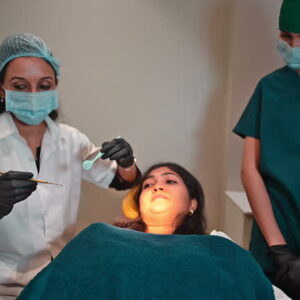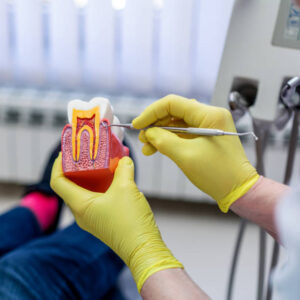Due to the stable chemical properties of zirconia ceramics, zirconia ceramics can resist body fluids without deterioration under normal physiological metabolism. Therefore, its coating material can be used for metal implantation and coating.
Biocompatibility as a bone substitute material, the porous skeleton made of zirconia can bear the load, and its surface layer is covered with hydroxyapatite to enhance the conductivity of bone and enhance bioactive materials.
Nowadays, the combination of zirconia ceramics and plastic tibial components has been used in medicine to replace the metal tray and plastic parts used in knee arthroplasty.
Experiments show that the new knee can not only maintain for 20-25 years, which is much more than the effective 15-20 years of cobalt-chromium alloy and polyethylene prosthesis but also self lubricate the new combination, so as to achieve smoother and easier articulation.
- Another important feature of zirconia ceramic material is its biocompatibility, which means that people who are allergic to nickel and cannot use knee prostheses made of cobalt chromium alloy (because nickel is a component of cobalt chromium alloy). Because it does not contain nickel, zirconia prosthesis completely eliminates the risk of nickel allergic patients.
Zirconia ceramic materials have performed well in orthopedic and dental applications, but long-term high-quality clinical data are still few, and concerns about the effects of wear, crystal degradation, crack propagation and catastrophic fracture are still debated.
- The future of zirconia in biomedical applications will depend on the generation of these data to solve problems. With the step-by-step solution of these problems, zirconia will have broad prospects in the medical field.
Characteristics of zirconia ceramics as dental materials
1.1 aesthetic performance
As we all know, the restoration of an anterior dental implant should not only restore the function but also give consideration to its aesthetic effect. When the current dental implant is titanium, the gingiva on the lip of the implant will produce shadow or gray more or less, which affects its aesthetic effect. Some scholars believe that when porcelain fused to metal crowns is used to repair anterior teeth, gingival staining is an easy post-repair complication, which is manifested in that the gingival margin or gingival and mucosal tissues are cyan gray or dark brown [3]. Therefore, the use of metal materials for restoration has obvious shortcomings, and zirconia ceramic materials are artificial materials that can reproduce the shape, color, and luster (including fluorescence and milky light) of natural teeth to the greatest extent. The aesthetic effect of Posts and cores made of traditional materials (gold or titanium) combined with all-ceramic crowns will become very uncoordinated due to the reflection and opacity of Posts and cores. It is worth popularizing and trying to use zirconia as posts and cores combined with IPS Empress all-ceramic crowns.
1.2 mechanical properties
In the mechanical properties, oral ceramic materials are characterized by high compressive strength, hardness, and wear resistance. Compared with alumina ceramics, zirconia ceramics show higher mechanical parameters (flexural strength exceeds 900MPa, fracture toughness is about 7mpam1 / 2, which is 2 ~ 3 times that of alumina ceramics), strong ultimate load capacity, and the bearing capacity on the three-unit tooth bridge is about 2000N. Fischer et al. Believe that compared with the bridges of IPS Empress zirconia ceramics and in Ceram alumina ceramics, the bridges made of zirconia ceramics show excellent mechanical properties and long-term reliability. The partial fixed denture with 3 dental units or less made of alumina ceramic and the partial fixed denture with 5 dental units or less made of zirconia ceramic can meet the clinical requirements, and the mechanical properties of zirconia ceramic prosthesis are better than that of alumina ceramic prosthesis. Due to the influence of microstructure and chemical composition on the mechanical properties of dental ceramics, zirconia ceramics have better mechanical properties than dental ceramics.
1.3 chemical stability
Oral ceramic material is the most stable material in oral materials. It has excellent biological properties whether implanted in vivo or used in the oral cavity. The ceramics made of zirconia not only have the biosafety basis of human application, have no cytotoxicity, but also can exist stably in the oral cavity, do not release harmful impurities, and do not degrade. Zirconia phase change toughened ceramics are used for the chemical stability and low-temperature aging properties of dental inlays and crowns and bridges. Zirconia phase change toughened ceramics have better mechanical properties than other dental ceramics, and the chemical stability can also meet the needs of dental ceramic materials. Zirconia ceramics can be used for coating metal implant materials because of their stable chemical properties and can withstand the action of body fluids without deterioration under normal physiological metabolism.
1.4 biocompatibility
The porous skeleton for bone substitute material is made of zirconia to bear the load. The surface layer is coated with hydroxyapatite to promote bone conductivity and improve the biological activity of the material. There is a layer of fluorapatite between the zirconia ceramic skeleton and HA to avoid chemical reactions between zirconia ceramic and ha. In vitro cell culture shows that the cells have good adhesion to this porous bone substitute material, The alkaline phosphatase activity of the cells is higher than that of the pure HA material, which proves that it is a new bone substitute material with good biological activity. In addition, CaF2 is added to ha zirconia ceramic composites, in which f-ions can partially replace hydroxyl groups in HA to form fluorapatite with better thermal stability, which effectively inhibits the degradation of HA to tricalcium phosphate (TCP), so as to obtain apatite zirconia ceramic composites with higher density and better strength and toughness, It was proved by cell culture in vitro that its induction effect on osteoblast-like cells was similar to that of HA material [10].
Research status of zirconia ceramics used in dentistry
Since the restoration with dense hot pressed alumina zirconia as the core has been used in dentistry, it has quickly become an eye-catching treatment style. With the improvement of manufacturing technology, simple clinical operation, and lovely aesthetic effects, it has become a very popular treatment choice. Zirconia ceramics are mainly used in the following aspects of stomatology.
2.1 zirconia all-ceramic dental restoration
Ceram technology is a technology for making all-ceramic crowns with high strength and low shrinkage. It is also the only manufacturing technology named after its patented technology in the production of dental ceramic crowns. In Ceram zirconia ceramic posterior fixed denture can be applied after 3 years of clinical observation, but long-term clinical research is needed before this material is recommended as a local fixed denture repair method. In addition, local et al reported a case of successful clinical application of zirconia ceramics as an implant crown system and pointed out that the material that can change gray gums is zirconia ceramics.
2.2 application of zirconia ceramics as root post
A metal post will cause MRI image distortion, and the metal post and core will affect the color matching and beauty of the anterior all-ceramic crown due to metal color and opacity. The ceramic post-core system has good biocompatibility and aesthetic characteristics. It is an excellent fixed prosthesis. When all-ceramic crowns are used in the clinic, ceramic posts and cores can provide a good aesthetic effect. Toksavul et al. Compared the fracture toughness and fracture mode of zirconia ceramic post and core, glass fiber reinforced post, and core and composite post and core after repairing upper central incisors. Zirconia ceramic post and core can be used in the clinic. At present, zirconia ceramic post-core is made of high toughness ceramic powder Y-Ce-TZP, because it not only retains the high strength of Y-TZP ceramics but also has the high toughness of CE TZP ceramics; On the other hand, the ce-y-mg composite stabilizer can toughen and strengthen zirconia ceramics. Because its high strength, good toughness, and mechanical properties can meet the requirements of dental posts and nails, it can be used for the manufacture of zirconia posts and cores. The fabrication process is to make the pre-formed zirconia rod as the wax core of the post-core, embed the cast porcelain, and try on the bonding, which is the same as the routine. Because zirconia ceramics is a kind of high-strength porcelain with high bending strength, and the matched special cast ceramics can be combined with zirconia piles to form ceramic pile core, it not only has good light transmittance but also has excellent mechanical properties.
2.3 Application of zirconia ceramics in dental implant
In order to improve the aesthetics through the color of the foundation post, an aluminum zirconium Machinable foundation post can be designed to repair the loss of a single tooth in the maxillary anterior tooth area. This beautiful cutting ceramic anterior teeth implant foundation post is formed by sintering alumina, plutonium oxide, and zirconia into a certain form of foundation post embryo, which can be cut and processed, and then infiltrated by glass frit.
Zirconia ceramic implant abutment not only has good oral material properties but also has excellent biocompatibility. Rimondini et al. Compared the colonization of Streptococcus mutans, Streptococcus haemolyticus, actinomycetes viscous, and Porphyromonas gingivalis on the surface of zirconia ceramic pile and pure titanium pile in vitro. It was found that the colonization of Streptococcus mutans on the surface of the zirconia ceramic pile was more than that of the titanium pile, and Streptococcus haemolyticus was easier to colonize on the surface of the titanium pile. In vivo experiments showed that the colonization amount of periodontal pathogens on the surface of titanium post was higher than that of zirconia ceramic post. The fracture resistance of the zirconia ceramic base is more than twice that of the alumina ceramic base.
The customization of zirconia crowns is easy to produce in a dental laboratory, dentist sends taken impression moulds to laboratory, then 3D dental lab scanner starts to analyze restoration data.

The followings step is the cad cam dentistry milling, then later prosthesis is placed in a zirconia sintering oven to make final sintering, polishing, and glazed.

- Conclusion
To sum up, the research results on the comprehensive properties of zirconia ceramics in dentistry show that zirconia ceramics have high application value and prospects, especially the zirconia nanoceramics that appeared in recent years. Its many excellent qualities, such as room temperature superplasticity, high toughness, and its application in function, can not be replaced by other ceramics. Therefore, zirconia ceramics will have a significant impact on the development of dentistry in the near future.





